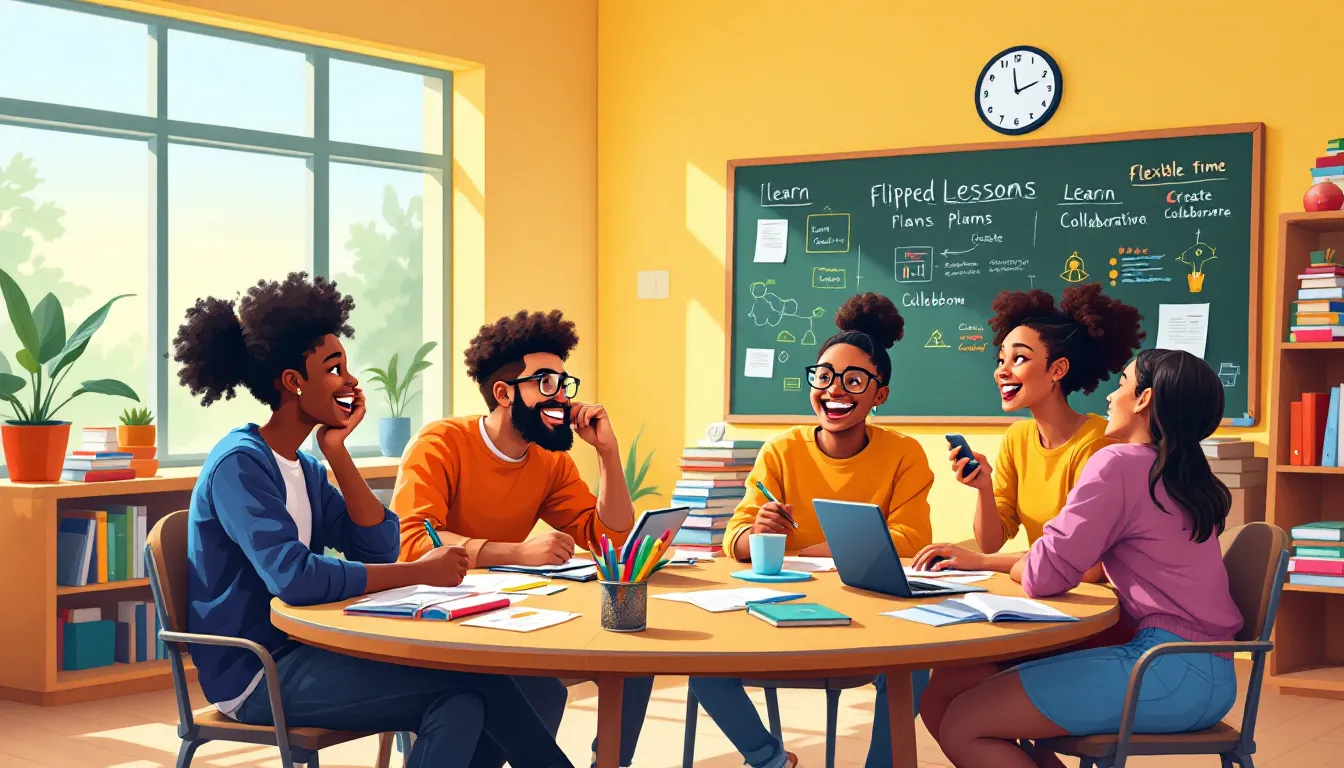Creating an inclusive classroom that supports the needs of all students can be challenging.
This article outlines practical strategies to build an inclusive environment where every student, regardless of background or ability, can thrive.
You'll learn how to embrace diversity through Universal Design for Learning, differentiated instruction, culturally responsive teaching, and more. Additionally, the article explores ways to foster equity, engage families, conduct assessments, and continually improve your inclusive practices.
Embracing Diversity in Teaching Practices
Defining Inclusion and Diverse Learners
Inclusive education means embracing all students regardless of their background, ability, or learning needs. It's about building a welcoming community where every student feels valued and can reach their full potential.
Diverse learners refers to students with varying abilities, strengths, backgrounds, languages, cultures, and learning needs. Some examples include students with learning disabilities, gifted students, English language learners, students from minority backgrounds, students with physical disabilities, and more.
Equity in education means providing each student what they individually need to succeed, which is not always equal treatment.
The Case for Inclusive Classrooms
Research shows inclusive classrooms where diverse learners' needs are met benefits all students, not just those with extra needs. Inclusive environments build empathy, resilience, leadership skills, and acceptance of differences. Students achieve better academic outcomes as well.
Inclusive strategies allow teachers to reach more learning styles. Collaborative, multi-ability grouping builds community. Identifying and removing barriers helps every student thrive.
Common Challenges
However, creating truly inclusive classrooms presents challenges like large class sizes, lack of training/resources for differentiated instruction, accessibility issues, and unconscious teacher biases.
With proactive planning, teacher collaboration, administrative support, and a commitment to equity, these obstacles can be overcome. Progress begins by acknowledging areas for improvement.
Effective Teaching Strategies for Diverse Learners
This section offers practical tips across 5 key areas that teachers can implement to better support diverse learning needs in their classrooms.
1. Universal Design for Learning (UDL)
The Universal Design for Learning (UDL) framework provides guidelines to make learning accessible for all students. Its three principles are:
- Multiple means of representation - Present information in multiple formats like text, images, video, audio, etc.
- Multiple means of action and expression - Allow students to demonstrate knowledge in various ways like projects, presentations, writing, etc.
- Multiple means of engagement - Stimulate interest and motivation through choices, collaboration, connection to prior knowledge, etc.
Teachers can apply UDL when planning lessons and activities by:
- Providing reading materials in both print and digital formats
- Using visual aids like graphic organizers and diagrams
- Allowing students to submit projects as videos, posters, papers, or presentations
- Creating tiered activities with options for various skill levels
- Connecting content to real-world examples and students' backgrounds
2. Differentiated Instruction
Differentiation strategies help tailor instruction to individual students' needs. Examples include:
- Flexible grouping - Group students by skill level or interest for targeted teaching
- Tiered assignments - Design tasks with varying levels of complexity
- Student choice - Allow choices in how students access content, demonstrate understanding, etc.
Other differentiation ideas:
- Customize the pace and flow of lessons
- Provide extra tools or support to struggling learners
- Develop extension activities for advanced students
3. Culturally Responsive Teaching
Culturally responsive teaching acknowledges and incorporates students' cultural backgrounds in the classroom. Strategies include:
- Learn about students' home cultures and languages
- Integrate diverse texts, materials, and perspectives into curricula
- Validate cultural diversity through an inclusive classroom environment and culture
- Implement cooperative learning structures for cultural exchange
- Teach cross-cultural communication skills
4. Explicit Skill Building
Targeted skill-building benefits diverse learners. Useful strategies involve:
- Breaking down multi-step instructions
- Allowing processing time before calling on students
- Teaching study skills like note-taking, organizing, time management explicitly
- Providing models, exemplars, and guided practice opportunities
Build skills through direct instruction, demonstrations, and scaffolded activities. Provide plenty of opportunities for practice and feedback.
5. Creating Rich Inclusive Environments
The classroom climate impacts diverse students' comfort, safety, motivation and achievement. Strategies to nurture inclusion involve:
- Displaying images, posters, student work reflecting diversity
- Rearranging seating, materials for accessibility
- Offering flexible or alternative seating options
- Setting classroom norms of respect for all cultures, identities
- Facilitating positive interactions through cooperative learning
- Promoting student voice and leadership
An inclusive classroom culture validates all students and makes them feel valued, empowered, and able to thrive.
sbb-itb-bb2be89
Teaching Strategies for Inclusive Education
Incorporating Activities to Promote Diversity
Teachers can incorporate various activities into their lessons to celebrate diversity and promote inclusion in the classroom. Here are some ideas:
- Have students research and present on their family backgrounds and cultures to the class. This allows students to take pride in their identities and teaches peers about different cultures.
- Read books and watch films featuring diverse characters and perspectives. Discuss the themes and what students took away from them.
- Organize potluck lunches where families can contribute dishes from their cultures. This allows students to try new foods while learning about their classmates.
- Create a "cultural exchange day" where students teach each other words and phrases from languages spoken at home. This promotes multilingualism and intercultural exchange.
- Decorate the classroom with student self-portraits, family photos, cultural artifacts brought from home, and maps showing family origins. This visually celebrates diversity.
- Have students interview family members about growing up experiences related to their background. Compiling these stories into a book reinforces that all cultures have value.
Strategies to Meet the Needs of Diverse Learners
Teachers must tailor their teaching strategies to effectively engage diverse students. Useful strategies include:
- Multi-modal instruction: Use visual aids, hands-on activities, demonstrations, etc. alongside lectures. This accommodates visual, auditory, and kinesthetic learners.
- Scaffolding: Break complex tasks down into simpler steps. Provide more support initially, then gradually withdraw it as students gain skills. This allows struggling learners to meaningfully participate.
- Flexible grouping: Let students work individually, in pairs, or in groups depending on the activity. Vary group composition to match learner needs. Groups promote peer learning while individual work accommodates different paces.
- Tiered assignments: Design activities with multiple complexity levels covering the same concepts. Students can select the level suiting their skills and needs.
- Culturally responsive teaching: Incorporate diverse cultural references and perspectives into lessons. Validate students' backgrounds to improve engagement among minority groups.
- Explicit skills instruction: Directly teach learning strategies like critical thinking, organization, note taking, etc. Don't assume students intuitively possess these skills. This levels the playing field.
Fostering a Culture of Equity and Inclusion
Teachers must proactively cultivate classroom environments where all students feel safe, valued, and supported. Strategies include:
- Establish shared values of respect, empathy, and appreciation for diversity. Consistently reinforce these in interactions and instructional content.
- Adopt policies promoting equal speaking time, leadership opportunities, collaborative work, and participation incentives for all students.
- Ensure classroom displays, learning materials, and content represent diversity in identities, cultures, perspectives, abilities, and experiences.
- Provide access to learning aids and assistive technologies tailored to students' needs.
- Intervene consistently against biased language, discrimination, stereotyping, and bullying.
- Teach students to identify and check implicit biases. Equip them to respectfully challenge biased language or behavior among peers.
- Maintain high expectations of every student. Continually challenge them to grow while providing support systems for those struggling.
Engaging Families and Communities
Successfully supporting diverse classrooms requires engaging students’ families and communities. Teachers should:
- Host family nights celebrating different cultures represented in the classroom.
- Maintain ongoing communication with families to understand individual students' needs.
- Invite community members as guest speakers to share diverse perspectives and experiences.
- Collaborate with community organizations to access resources supporting inclusion initiatives and diverse learners’ needs.
- Encourage students to identify and engage with community issues related to diversity, equity and inclusion through projects and assignments.
By authentically engaging families and communities, teachers gain crucial insights and allies in ensuring classrooms meet all students' needs.
Assessment, Reflection and Continual Improvement
Assessing Student Needs
Regular assessment allows teachers to understand the diverse learning needs within their classrooms. Both formal and informal assessments can uncover areas where certain students require additional support or alternative teaching methods. Examples of informal assessments include observation, class discussions, journal entries, and one-on-one conferences. These provide real-time insight into student comprehension and engagement. Formal assessments like tests, projects, and writing assignments also indicate whether some students need modified objectives or supplemental instruction. Teachers should continually assess through various means to identify learning gaps and tailor their teaching accordingly.
Evaluating and Improving Your Practice
Creating an inclusive classroom is an ongoing process that requires self-reflection around areas of personal strength and areas for growth. Teachers can ask themselves questions like:
- What teaching methods am I using that appeal to diverse learning styles?
- Which students appear less engaged during certain lessons?
- Have I made efforts to spotlight diverse voices and perspectives?
- Are there certain groups of students I should make an effort to better understand?
Identifying even small ways to improve will incrementally work toward a more inclusive environment. Teachers can also seek input from students, parents, administrators, and fellow educators to gain outside perspective.
Expanding Your Toolkit
While self-assessment is important, teachers must also actively expand their knowledge around best practices for reaching diverse learners. They can accomplish this through:
- Workshops and Conferences: Various professional development events provide instructional strategies tailored to diverse learners.
- Communities of Practice: Local and online groups allow collaborative idea exchange around inclusion.
- Reading Literature: Journals, magazines, and books offer new evidence-based techniques.
An inclusive classroom requires continually learning and growing. Pursuing professional development creates classrooms responsive to all students' needs.


